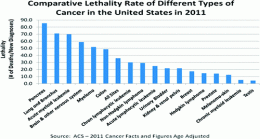Turning up the heat to kill cancer cells: The 'Lance Armstrong effect'

The "Lance Armstrong effect" could become a powerful new weapon to fight cancer cells that develop resistance to chemotherapy, radiation and other treatments, scientists say in a report in the ACS journal Molecular Pharmaceutics.
Robert Getzenberg and Donald Coffey explain that many advances have occurred in the 40 years since President Nixon declared a "War on Cancer" on December 23, 1971. However, cancer remains a leading cause of death worldwide, claiming almost 8 million lives annually. Patients with some forms of cancer respond well to treatment, while others have disease that becomes resistant to every known treatment.
Patients with testicular cancer have a high survival rate — more than 70 percent — even if the cancer metastasizes, or spreads. For example, Lance Armstrong, the famous cyclist, beat metastatic testicular cancer that spread to his lungs and brain, and then went on to win the Tour de France a record seven consecutive times. But patients with pancreatic cancer have only a 25 percent survival rate in the first year and a 6 percent survival rate by the fifth year after diagnosis. Why is this?
Getzenberg and Coffey realized that the microenvironment of testicular cancer cells was a little different. Testicles are usually several degrees cooler than the rest of the body, owing to their position outside the body. When cancer cells from the testicles spread to other organs, such as the lungs or brain, they encounter a warmer environment. The researchers propose that this warmth shocks the tumor cells, making them more susceptible to conventional cancer therapies, which leads to a higher survival rate among testicular cancer patients. This is the so-called "Lance Armstrong effect." The researchers describe tests now underway on nanoparticle therapies to specifically heat other types of tumors above their normal temperatures to see whether this effect holds true for non-testicular cancers.
More information: Changing the Energy Habitat of the Cancer Cell in Order To Impact Therapeutic Resistance, Mol. Pharmaceutics, Article ASAP. DOI: 10.1021/mp200310u
Abstract
Somatic cellular evolution is becoming a popular biological explanation for the common rapid development of resistance to almost every form of cancer therapy and against almost every form of advanced human solid tumors. As a result of the historical power of evolution within nature, this common biological interpretation of the failure of cancer therapy is leading to a growing despair for many investigators and a stronger turn toward prevention through lifestyle changes. The absolute explosion of molecular scientific discoveries since 1983, in the reductionist identification of specific cancer therapeutic targets, has failed to deliver the impact in the clinic that many of us would have hoped would have resulted by this time. Personalized molecular medicine may help us reclassify appropriate therapeutic subgroups, but will it significantly impact the overall specific survival times for all of the cancers combined within the organ type for the entire population? How might we approach this therapeutic dilemma by utilizing new therapeutic insights designed on proven principles of evolution? In other words, can we fight the development of therapeutic resistance in cancer cells by turning established aspects of evolution against the survival of cancer cells within the individual patient? Here we review the concepts of changing the heat habitat and microenvironment of the cancer cell to alter the higher order organization and function of DNA. We have proposed that heat may be a major factor in determining the lasting therapeutic effect on many types of far advanced metastatic tumors.















